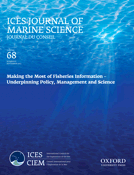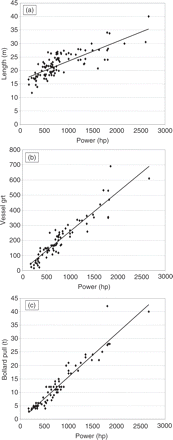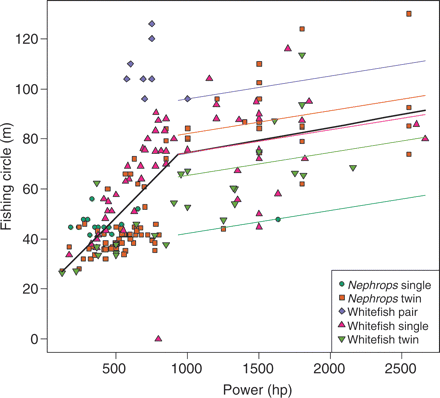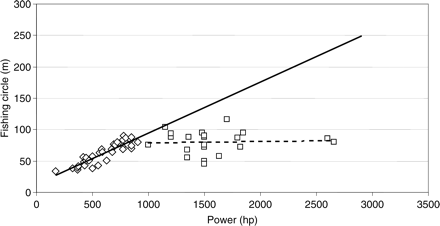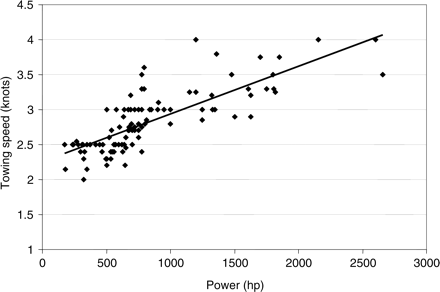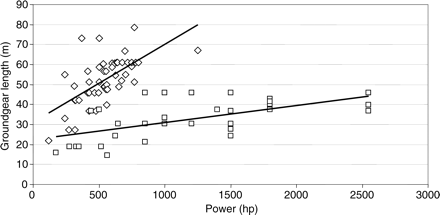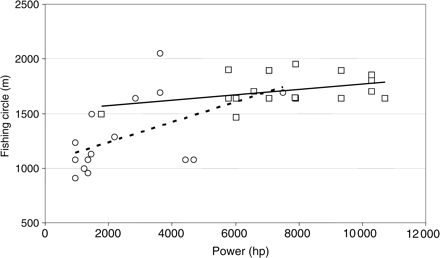-
PDF
- Split View
-
Views
-
Cite
Cite
D. G. Reid, N. Graham, D. J. Rihan, E. Kelly, I. R. Gatt, F. Griffin, H. D. Gerritsen, R. J. Kynoch, Do big boats tow big nets?, ICES Journal of Marine Science, Volume 68, Issue 8, September 2011, Pages 1663–1669, https://doi.org/10.1093/icesjms/fsr130
Close - Share Icon Share
Abstract
Fishing vessel capacity for trawlers is generally expressed in terms of length, tonnage, and engine power, assuming that a larger vessel has a greater fishing power. Management uses effort-control measures such as kW-day limits based on this assumption. Many studies have shown a weak and noisy relationship between effort and modelled catches, and explanatory models often require the inclusion of a skipper or vessel effect to explain the variance. A key element in this effect is the choice of gear size. Relationships are investigated between metrics of the vessel (length, tonnage, and power) and the gear towed (length of groundgear, or circumference of the net opening) in Scottish and Irish whitefish, Nephrops, and pelagic otter trawlers. Often, the vessel size did not correlate with that of the gear, or did so only for smaller vessels (<1000 hp). The key implication is that effort management based on vessel metrics alone is not appropriate, because it is a poor predictor for gear size, and hence for fishing power. Effort restrictions may actually encourage the adoption of larger gears for a given vessel, to maximize the value of a limited-time resource.Reid, D. G., Graham, N., Rihan, D. J., Kelly, E., Gatt, I. R., Griffin, F., Gerritsen, H. D., and Kynoch, R. J. 2011. Do big boats tow big nets? – ICES Journal of Marine Science, 68: 1663–1669.
Introduction
Fishing-vessel capacity is a term commonly used in fishery management. It is generally measured by physical metrics of the vessel such as its power or tonnage, as in the EU Multi-Annual Guidance Programme (MAGP) regulations (Pascoe and Coglan, 2000), and in the vessel capacity unit scheme used in the UK. It can also be expressed in terms of fishing power related to the vessel's ability to catch fish (Pascoe et al., 2001). The fishing power of a particular gear is defined (Gulland, 1964) as the product of the area of influence of the gear during a unit fishing operation, and its efficiency during that operation. The general assumption, particularly into capacity-management regimes, is that the physical characteristics translate to fishing power (Cotter, 2009). The bigger the vessel, the greater the fishing power, in particular for trawlers. This perception also translates through to effort management. Effort can be defined as the use of capacity with time, so effort control is often expressed in kW-days. Then, if a vessel has twice the engine power, it gets half as many days at sea. However, various studies have shown that vessel size and effort can only partially explain differences in fishing power (Marchal et al., 2004; Pout et al., 2008). This is often treated as a human or a skipper factor, but it represents the non-physical or unaccounted factors in evaluating fishing power. One issue commonly overlooked is that fishing is actually done by a net, towed by a vessel, so arguably fishing power should consider both components of the fishing system, i.e. the vessel and the gear. One source of the skipper factor could be the choice, design, and rigging of the nets utilized.
It may seem obvious that within a given métier, a large vessel would tow a large net, and a small vessel a small net. It might be assumed that a skipper would tow the largest net possible by his vessel, to maximize catches and hence revenue. This assumption is obviously made when allocating kW-days in effort-control regimes, but is it correct? We examined this question using data from otter and pairtrawlers working in the mixed whitefish, Nephrops, and pelagic sectors in Scotland and Ireland. The aim was to examine whether vessel size (here interpreted as power) was a good predictor of the size of the net towed by the boat. The implications of the findings in the context of effort-control management, and the potential for unintended outcomes of such measures, are also discussed.
Material and methods
Gear and vessel data were available for the Scottish fleet from two sources. The first was a questionnaire survey carried out under the Scottish Industry Science Partnership (SISP) in 2007 (Gatt and Reid, 2007). This provided physical details of the vessels and their main fishing gear. The second source was a series of engineering trials carried out on Scottish vessels (Kynoch, 2005; Kynoch and Penny, 2006). These provided some details of both vessels and gears, but were less comprehensive. Common factors in both datasets included power, length, and tonnage for the vessel, and for the gear, the groundgear length and fishing circle (i.e. the circumference as the stretched-mesh size around the net opening). Data for the Irish fleet were obtained from personal contacts within the industry, and engineering trials conducted by the Irish Sea Fisheries Board (BIM).
Vessel metrics
For Scottish and Irish demersal vessels (whitefish and Nephrops), data were available for length and power, but not always for tonnage. In this paper, the latter term means the gross registered tonnage (grt). In general, there was a strong relationship between power and length (r2 = 0.62, p < 0.01) or grt (r2 = 0.87, p < 0.01; Figure 1a and b).
Plots of vessel characteristics against engine power. (a) Lengths of the Scottish and Irish demersal vessels sampled (r2 = 0.62). (b) Grt for Scottish demersal vessels (r2 = 0.87). (c) Bollard pull for Scottish demersal vessels (r2 = 0.91). Trendlines are linear least-squares fits.
Bollard pull is often proposed as a better indication of a vessel's actual power in operation, rather than engine power. Bollard pull takes account of other factors in the vessel design, e.g. propeller, nozzle, hull, and gearing. Such data were not available for all vessels, but for those available, the relationship with engine power is plotted in Figure 1c; there is a strong relationship (r2 = 0.91, p < 0.01), suggesting that power and bollard pull are closely linked. Based on this, and for the purposes of this study, we chose to use engine power as the capacity metric for comparison with gear metrics.
Throughout this paper, horsepower (hp) is used as the unit of engine power, because hp is the normal terminology used by industry in Scotland and Ireland. The SI conversion factor is 1 kW = 0.746 hp.
Gear-size metrics
The choice of appropriate gear metrics is less clear; there are many ways of measuring the size of a net. Based on the commonalities between the two data sources, our examination of the gear–vessel relationship focused on the groundgear and fishing-circle lengths. For the groundgear, total length, including the footrope and any extensions, was used, so providing a rough indication of the horizontal spread of the gear. In general, the longer the groundgear, the greater is the expected spread. However, many other gear components affect the spread, e.g. door size and design, bridle, sweep, and warp lengths, and towing speed, water currents, and seabed conditions.
The fishing circle was determined (in metres) from information on the stretched mesh size at the front of the net and the number of meshes around the opening. The fishing-circle and groundgear-length metrics were considered as representing the fishing power of the net by métier. The greater the fishing circle and/or groundgear length, the greater the fishing power. This follows Gulland (1964), who also included fish-catching efficiency in his definition of fishing power, but no efficiency data were available for the analysis here. With the data available, it was not possible to calculate either the cross-sectional area (CSA) of the net opening or the actual swept volume. However, it is reasonable to assume that a larger fishing circle would result in a larger CSA, and hence swept volume. On that basis, we selected fishing circle as a proxy metric. Again, no data were available to estimate swept area, so groundgear length was used as a proxy metric.
Analysis
The effect of vessel power on groundgear length and fishing circle for Scottish and Irish (i) mixed demersal whitefish, and (ii) Nephrops trawlers, was initially analysed on pooled data using a segmented regression approach (Muggeo, 2003), to identify breakpoints in the data. Visual examination of simple scatterplots suggested that smaller vessels might have a closer relationship between vessel power and gear size than larger vessels. Then, for vessels with engine sizes above the breakpoint, generalized linear models (GLMs) were fitted, with a Gaussian error distribution and an identity link function (McCullagh and Nelder, 1989). For fishing circle (groundgear length) of mixed demersal whitefish trawlers, the full model had the form glm(circle ∼ power × sector), where sector was based on the fishery and the broad gear type used; single otter gear (whitefish single and Nephrops single), twin otter gear (whitefish and Nephrops twin), and Nephrops pairtrawl. The full model for pelagic trawlers contained only power as the explanatory variable. All other analyses including those for pelagic trawlers were carried out using simple linear least-square regression. The explanatory power (goodness-of-fit) was measured by the coefficient of determination (r2), and the statistical significance of the regressions was determined using the F-statistic.
Results
Power and fishing circle for pooled data on demersal trawlers
Initial analysis of the pooled data for vessel power (hp) was carried out using a segmented regression approach, to establish any potential breakpoints in the data, followed by GLM analysis where appropriate (Figure 2). The data clearly showed different patterns above and below 934 hp. Below this value, there was a clear, if noisy, relationship (r2 = 0.22, p < 0.01). Above this value, the GLM analysis was carried out. For the fishing-circle model, the interaction between power and segment did not contribute significantly, so it was dropped. In addition, the power variable was not significant (F = 2.79; d.f. = 1; p = 0.10), but dropping power from the model resulted in a small increase in the Akaike information criterion (AIC), from 522.63 to 523.64. The sector variable was significant (F = 3.11; d.f. = 4; p = 0.02).
The relationship between fishing circle and vessel power. The black line is the segmented regression, and the coloured lines show the GLM fitted to data above the breakpoint of 934 hp.
Taken together, these results indicate that below a cut-off of 934 hp, there was a significant relationship between power and fishing circle. Above the cut-off, there was no such relationship, and the main factor influencing fishing circle was the type of fishing (sector).
The picture is even clearer if one examines a single segment of the fleet, e.g. whitefish single-trawl vessels (Figure 3). There is a clear relationship between power and fishing circle for vessels <934 hp (r2 = 0.81, p < 0.01), and none for the larger ones (r2 = 0.0004, p = 0.83). This suggests that vessels <934 hp tend to deploy the largest practicable gears, presumably to catch the most fish. In addition, there is relatively little variability in the relationship. Not only do the larger vessels show no such relationship, but there is also greater variability. For instance, at ∼1500 hp, there are vessels with fishing circles ranging from <60 to >120 m. Even the largest vessels had fishing circles close to the average. In addition, one of the largest vessels (1360 hp) towed the net with the smallest fishing circle (24.4 m). Interestingly, if the trend for the smaller vessels is extrapolated over the whole power range, there is an indication that some larger vessels match the power/circumference relationship of the smaller vessels, but most do not (Figure 3).
The relationship between fishing circle and vessel power for Scottish whitefish single-gear trawlers. Open diamonds represent vessels below the 934 hp breakpoint, and open squares vessels above the breakpoint. Regression lines are linear least-squares fits, and the regression line for the smaller vessels has been extended over the full range of vessel power.
Power and towing speed for demersal trawlers
Given the lack of any relationship between power and fishing circle for the larger vessels, an obvious question would be what the power is used for. In the SISP questionnaire (Gatt and Reid, 2007), respondents were asked for their normal towing speed with the gear described. Clearly, this would depend on variable external factors such as tides, weather, and ground conditions. However, Figure 4 shows a weak but significant relationship between vessel power and the stated towing speed (r2 = 0.10, p < 0.01) for the Scottish whitefish single-trawl vessels. Across the range of powers, towing speed increased from ∼3 knots for the smallest vessels to almost 4 knots for the largest. If this relationship is accepted, the implication is that the additional power available to the larger vessels is used, at least in part, to tow faster. If that was so, more ground would be covered per fishing hour, which might be expected to increase the catch rate, although there may also be implications for the selectivity of the net at different speeds (Dahm et al., 2002).
The relationship between vessel fishing speed and vessel power for Scottish whitefish single-gear trawlers. The regression line is a linear least-squares fit.
Power and groundgear length for demersal trawlers
A similar analytical approach was taken for the relationship between power and groundgear length (Figure 5). The data clearly showed different patterns above and below 418 hp in this case. Below that value, there was a clear, though even more noisy, relationship (r2 = 0.12, p < 0.01). Above that value, the GLM analysis was carried out.
The relationship between groundgear length and vessel power. The black line is the segmented regression, and the coloured lines show the GLM fitted to data above the breakpoint of 418 hp.
Again, the interaction factor was insignificant and was dropped, but both power and sector were significant (F = 4.32, d.f. = 1, p = 0.04; and F = 5.75, d.f. = 4, p < 0.001, respectively). However, the relationship between power and groundgear length for the vessels >418 hp was actually negative and quite small.
Power and groundgear type and length for Nephrops twin trawl vessels
The database contained a total of 84 twin trawl vessels operating in the Nephrops fisheries in Scotland and Ireland. Of these, 34 used rock-hopper groundgear. Here, a rock-hopper gear is defined by the groundgear disc diameter being >20 cm. The other 50 vessels used so-called clean gear, i.e. with discs <20 cm. Figure 6 shows the relationships between power and groundgear length for these two categories. Both have significant relationships (rock-hopper vessels r2 = 0.37, p < 0.01; clean gear vessels, r2 = 0.41, p < 0.01). Moreover, the two relationships are significantly different (p < 0.01).
The relationship for Scottish and Irish Nephrops twin-gear trawlers between groundgear length for vessels towing gear with rock-hoppers (open squares) and those with clean groundgear (open diamonds).
Scottish and Irish pelagic trawling for mackerel
There was no significant relationship between vessel power and fishing circle for either Scottish (r2 = 0.16, p = 0.11) pelagic vessels targeting mackerel (Scomber scombrus) or Irish vessels (r2 = 0.26, p = 0.053; Figure 7). Note that the range of engine powers between the two countries is different. The Scottish fleet tends to consist of more modern and powerful vessels (mean construction year 2002; mean power 7690 hp) than the Irish fleet (mean construction year 1996; mean power 2267 hp). This pattern of a better relationship between gear size and vessel power for smaller vessels was also seen in several of the whitefish groupings, particularly single-trawl vessels.
The relationship between vessel power and fishing circle for Scottish (open squares) and Irish (open circles) pelagic trawlers targeting mackerel. The regression lines are linear least-squares fits.
Discussion
The main conclusion from the study is that no simple relationship exists between a fishing vessel's power and the size of the net it tows. For the demersal sectors evaluated (whitefish and Nephrops, single, twin, and pair trawl), there was evidence of different relationships for the smaller and the larger vessels. For both gear metrics (fishing circle and groundgear length), only the smaller vessels showed a significant positive relationship.
A good example of this complex relationship was seen among the whitefish single-trawl vessels. Using a breakpoint for the regression above and below 934 hp, a good relationship was found for the low-power vessels, but no significant relationship for the high-power group. This implies that the larger (>934 hp) vessels could tow much larger nets than they currently do. This raises the question of what would happen if all the vessels towed as large a net as possible. The fishing circle is a standard metric for expressing the size of a net opening, but in the context of fishing power, a more useful metric might be its CSA. This multiplied by the tow distance could estimate the swept volume of the net. Without better gear-monitoring data, it is impossible to ascertain the exact shape of the net opening, but a circular opening has been assumed as a rough approximation. Then, the small-vessel relationship between engine power and the fishing circle can be used to calculate the maximum potential CSA for the larger vessels. The estimated total CSA for the 15 larger vessels was 8696 m2. The maximum potential CSA, from extrapolation of the small-vessel relationship, was estimated to be 15 128 m2, some 74% more, so, for example, the largest vessels in the sample, with the fishing power of ∼2600 hp, could tow gears with fishing circles of ∼135 m, compared with the 80–85 m in current practice.
Perhaps a more realistic approach to estimating this potential or latent capacity would be to base the calculations on the actual nets used by the larger vessels. Two vessels stood out from the dataset. The first (1150 hp) towed a net with a fishing circle of 104 m, and the second (1700 hp) a net with a fishing circle of 116 m. From this, we assume that all vessels between 1150 and 1700 hp can tow a net of circumference 104 m, and that those of >1700 hp can tow a net with a fishing circle of 116 m. On this basis, the total potential CSA for the 15 larger vessels was calculated as 14 178 m2, an increase of ∼63% over the current scenario. It must be emphasized again that we do not know the actual CSA of these nets, so these potential increases are only rough approximations.
In both the Scottish and Irish pelagic fishery for mackerel, it is clear that the net size is not linked to vessel power. It is likely that the net size is selected for operational reasons, whereas vessel power is related to other factors, particularly the ability to land catches quickly to secure premium prices for fresh fish. The older and lower-powered Irish fleet did show some evidence of a relationship between vessel power and gear size, although the relationship was not statistically significant, suggesting that they tended to select the largest net that they could deploy effectively. For the Scottish fleet fishing herring (Clupea harengus), data were only available for nine vessels. All used exactly the same gear size (a fishing circle of 1000 m), with one exception of ∼1500 m.
In this study, we used the limited data available on gear dimension, and took groundgear length and fishing circle as being rough proxies for swept area and volume. The last two parameters are those of more direct interest. Many commercial vessels carry gear-monitoring systems that can be used to determine swept areas and volumes accurately, although no such data were available for the present study. Any future work should therefore be developed using comprehensive gear-performance data in addition to the physical sizes of the gear components.
The main principal aim of the study was to determine whether vessel size was a good predictor of the size of gear towed; often it is not. However, the finding raises the question of why a skipper might select a smaller net than his vessel could tow. Personal enquiries of skippers and owners suggest that the net size is essentially a commercial decision aimed at the best uptake of available quota, taking into consideration not only the efficiency of the gear, but also fuel consumption. Hence, fishing boats may not tow the largest gear possible. Anecdotal information from fishers also suggests that fishing the same net with more engine power can result in bigger catches. Other reasons for choosing a smaller net could include physical constraints on deck space, capability for longer trips, or operational issues such as being able to fish in poor weather. In the pelagic sector, excess engine capacity is used for other purposes, such as seawater refrigeration and faster cruising, to reduce the transit time to markets, to maintain catch quality, and to obtain better prices.
Conclusions and implications
The study was based on the operating assumption that fishing power is a function mainly of the size of the net, rather than the vessel's engine power. Therefore, vessels of 500 and 1000 hp towing the same size of net, at the same speed, would have the same fishing power. It should be noted, though, that there were indications from the Scottish demersal fleet that more powerful vessels might actually tow faster.
It is beyond the scope of this paper to determine exactly why vessels might opt for smaller nets, and the core finding remains that any link is complex and non-linear. Nevertheless, it is likely that the size of the gear towed is the main factor in understanding fishing power. On that basis, two broad conclusions emerge from this study. The first is straightforward, showing that for many fleet segments in Scotland and Ireland, vessel power is not a good predictor for gear size, and hence fishing power. As most effort-control regimes are based on the kW-day approach, this finding suggests that not including the gear size in the calculations is a major flaw. Moreover, as some fleet segments did show a relationship between power and gear size, whereas others did not, effort management needs to be considered in more detailed categories, such as the whitefish single-trawl vessels above and below 934 hp. The second conclusion is more complex. Many of the vessels studied evidently towed gears that were much smaller than, theoretically at least, they could deploy. This could be described as inefficiency in the use of vessel capacity. If a more constraining effort (kW-day) regime were imposed, then a large vessel that had towed a small gear would have the option of increasing the net size to maintain its catching potential despite the reduced number of days available. If the net size does represent fishing power, then such action could mitigate, or even negate, the intended impact of the management measure. For the whitefish single-trawl vessels, the potential fishing-power increase is in the order of 70%.
Acknowledgements
This work was carried out within the ICES Study Group on combining gear parameters into effort and capacity metrics (SGEM; ICES, 2009). The work was partially supported by the Beaufort Marine Research Award on the Ecosystem Approach to Fisheries Management, carried out under the Sea Change Strategy and the Strategy for Science Technology and Innovation for Ireland (2006–2013), with the support of the Marine Institute, funded under the Marine Research Sub-Programme of the National Development Plan 2007–2013.


